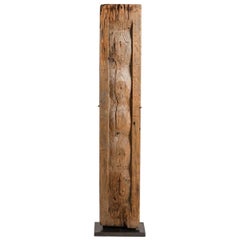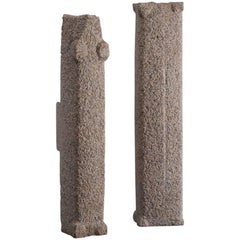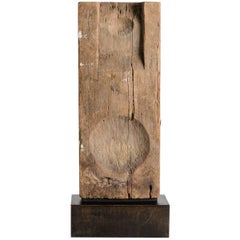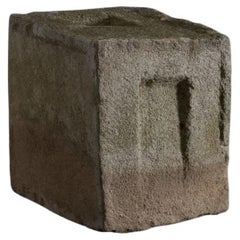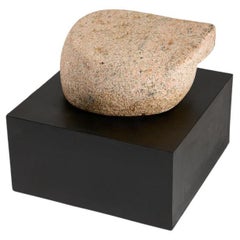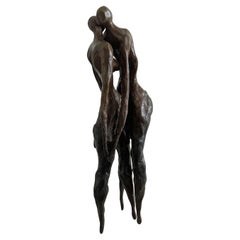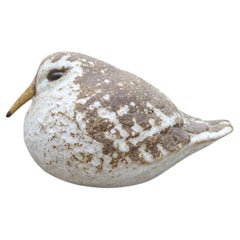Yongjin Han Furniture
to
14
8
6
8
6
8
1
2
2
9
8
4
1
1
14
14
14
14
14
14
7,546
3,967
2,548
2,244
Creator: Yongjin Han
Yongjin Han, a Piece of Wood, Sculpture, United States, 1976
By Yongjin Han
Located in New York, NY
Unique piece.
Sculpted in 1976, this is a rare piece for the famed sculptor Yongjin Han, who usually worked in stone. Nonetheless, it is a quintessential example of his serene com...
Category
Late 20th Century American Yongjin Han Furniture
Materials
Wood
Yongjin Han, "Two Standing Stones, " Vertical Sculpture, United States, 2017
By Yongjin Han
Located in New York, NY
Yongjin Han was born in Seoul, South Korea in 1934. After the Korean War—in which he fought, lying about his age in order to enlist—he was one of six students admitted to the sculptu...
Category
Late 20th Century American Other Yongjin Han Furniture
Materials
Granite
Yongjin Han, Two Pieces of Stone, Granite Sculpture, United States, 1993
By Yongjin Han
Located in New York, NY
Yongjin Han was born in Seoul, South Korea in 1934. After the Korean War—in which he fought, lying about his age in order to enlist—he was one of six students admitted to the sculptu...
Category
1990s American Yongjin Han Furniture
Materials
Granite
Yongjin Han, Piece of Wood, Sculpture, United States, 1976
By Yongjin Han
Located in New York, NY
Yongjin Han was born in Seoul, South Korea in 1934. After the Korean War—in which he fought, lying about his age in order to enlist—he was one of six students admitted to the sculpture program at the Seoul National University. At the time of his enrollment little of his native city remained intact; nonetheless, he had never felt more responsible to his work, firm in the conviction that artistic expression is every bit as essential to life and human nature as eating, drinking, or breathing.
One of Han’s teachers was Kim Chong Yung, a pioneer of Korean abstract sculpture, and by the time of his graduation he had adopted the abstraction that had seized both Europe and the United States several years before. . In 1967 he relocated to the USA, where he studied at Dartmouth and Columbia. Over the course of his long career the artist returned to Korea with frequency and made extended stays in Japan and Europe.
Trips to Korea signified something more than mere homesickness: Han’s work, though made largely in America, remained grounded in his rich cultural heritage. Korea rests on a bedrock of granite, and freestanding sculpture produced of the stone has for centuries demarcated sites of historical and religious significance. Han’s sculpture bridges this past with modernity. Richard A. Born, former Curator at the Smart Museum at the University of Chicago, has said that Han “brought Korea’s tradition of direct stone carving out of figuration into a refined, non-objective abstraction.”
For his part, Han put very little stock in designations; his focus, instead, was on the stone itself. His pieces explore a certain harmonization with nature. Han, when describing his work, said, "As stone has been around since the beginning of time, it has much to teach us if we care to slow down and listen." He believed that each stone has its own history, character, and energy and that his task was to draw out these inherently spiritual qualities. He described his process as a “dialogue” with his material: "The stone tells me it has an itch in a certain spot, so I scratch it—and we both feel better!"
Han worked alone and with manual tools, and the process is arduous. Carving stone this way takes time, and, what’s more, required great force—yet Han’s sculptures, even the monumental ones, are, as friend and fellow artist David Parker...
Category
Late 20th Century American Yongjin Han Furniture
Materials
Wood
Yongjin Han, A Piece of Stone, Granite Sculpture, United States, c. 1984
By Yongjin Han
Located in New York, NY
Yongjin Han was born in Seoul, South Korea in 1934. After the Korean War—in which he fought, lying about his age in order to enlist—he was one of six students admitted to the sculptu...
Category
1980s American Vintage Yongjin Han Furniture
Materials
Granite
Yongjin Han, Untitled, Sculpture in Pink Granite, United States
By Yongjin Han
Located in New York, NY
Yongjin Han was born in Seoul, South Korea in 1934. After the Korean War—in which he fought, lying about his age in order to enlist—he was one of six students admitted to the sculpture program at the Seoul National University. At the time of his enrollment little of his native city remained intact; nonetheless, he had never felt more responsible to his work, firm in the conviction that artistic expression is every bit as essential to life and human nature as eating, drinking, or breathing.
One of Han’s teachers was Kim Chong Yung, a pioneer of Korean abstract sculpture, and by the time of his graduation he had adopted the abstraction that had seized both Europe and the United States several years before. . In 1967 he relocated to the USA, where he studied at Dartmouth and Columbia. Over the course of his long career the artist returned to Korea with frequency and made extended stays in Japan and Europe.
Trips to Korea signified something more than mere homesickness: Han’s work, though made largely in America, remained grounded in his rich cultural heritage. Korea rests on a bedrock of granite, and freestanding sculpture produced of the stone has for centuries demarcated sites of historical and religious significance. Han’s sculpture bridges this past with modernity. Richard A. Born, former Curator at the Smart Museum at the University of Chicago, has said that Han “brought Korea’s tradition of direct stone carving out of figuration into a refined, non-objective abstraction.”
For his part, Han put very little stock in designations; his focus, instead, was on the stone itself. His pieces explore a certain harmonization with nature. Han, when describing his work, said, "As stone has been around since the beginning of time, it has much to teach us if we care to slow down and listen." He believed that each stone has its own history, character, and energy and that his task was to draw out these inherently spiritual qualities. He described his process as a “dialogue” with his material: "The stone tells me it has an itch in a certain spot, so I scratch it—and we both feel better!"
Han worked alone and with manual tools, and the process is arduous. Carving stone this way takes time, and, what’s more, required great force—yet Han’s sculptures, even the monumental ones, are, as friend and fellow artist David Parker says, “all gentle grace and warmth” … [the sculptor] “engages with the stone as an equal—like wayfarers meeting on a path, Han and a stone spend time together and when they part, both are marked and changed forever.”
Yongjin Han's career spanned decades and continents, and included several prestigious large-scale public commissions. In Seoul his work can be found at the National Museum of Contemporary Art, the IE Young Museum of Contemporary Art, the Whanki Museum, the Ewha Woman’s University Museum, Posong High School, and the 88 Olympics...
Category
21st Century and Contemporary American Yongjin Han Furniture
Materials
Granite
Yongjin Han, a Piece of Stone, Sculpture, United States, 2002
By Yongjin Han
Located in New York, NY
A piece of stone, a sculpture by Korean-American artist Yongjin Han.
Category
21st Century and Contemporary American Yongjin Han Furniture
Materials
Granite
Yongjin Han, Two Pieces of Bluestone, Sculpture, United States, 2010
By Yongjin Han
Located in New York, NY
Yongjin Han was born in Seoul, South Korea in 1934. After the Korean War—in which he fought, lying about his age in order to enlist—he was one of six students admitted to the sculpture program at the Seoul National University. At the time of his enrollment little of his native city remained intact; nonetheless, he had never felt more responsible to his work, firm in the conviction that artistic expression is every bit as essential to life and human nature as eating, drinking, or breathing.
One of Han’s teachers was Kim Chong Yung, a pioneer of Korean abstract sculpture, and by the time of his graduation he had adopted the abstraction that had seized both Europe and the United States several years before. . In 1967 he relocated to the USA, where he studied at Dartmouth and Columbia. Over the course of his long career the artist returned to Korea with frequency and made extended stays in Japan and Europe.
Trips to Korea signified something more than mere homesickness: Han’s work, though made largely in America, remained grounded in his rich cultural heritage. Korea rests on a bedrock of granite, and freestanding sculpture produced of the stone has for centuries demarcated sites of historical and religious significance. Han’s sculpture bridges this past with modernity. Richard A. Born, former Curator at the Smart Museum at the University of Chicago, has said that Han “brought Korea’s tradition of direct stone carving out of figuration into a refined, non-objective abstraction.”
For his part, Han put very little stock in designations; his focus, instead, was on the stone itself. His pieces explore a certain harmonization with nature. Han, when describing his work, said, "As stone has been around since the beginning of time, it has much to teach us if we care to slow down and listen." He believed that each stone has its own history, character, and energy and that his task was to draw out these inherently spiritual qualities. He described his process as a “dialogue” with his material: "The stone tells me it has an itch in a certain spot, so I scratch it—and we both feel better!"
Han worked alone and with manual tools, and the process is arduous. Carving stone this way takes time, and, what’s more, required great force—yet Han’s sculptures, even the monumental ones, are, as friend and fellow artist David Parker...
Category
21st Century and Contemporary American Yongjin Han Furniture
Materials
Stone
Yongjin Han, Untitled, Sculpture in Bronze, United States, 1996
By Yongjin Han
Located in New York, NY
Yongjin Han was born in Seoul, South Korea in 1934. After the Korean War—in which he fought, lying about his age in order to enlist—he was one of six students admitted to the sculpture program at the Seoul National University. At the time of his enrollment little of his native city remained intact; nonetheless, he had never felt more responsible to his work, firm in the conviction that artistic expression is every bit as essential to life and human nature as eating, drinking, or breathing.
One of Han’s teachers was Kim Chong Yung, a pioneer of Korean abstract sculpture, and by the time of his graduation he had adopted the abstraction that had seized both Europe and the United States several years before. . In 1967 he relocated to the USA, where he studied at Dartmouth and Columbia. Over the course of his long career the artist returned to Korea with frequency and made extended stays in Japan and Europe.
Trips to Korea signified something more than mere homesickness: Han’s work, though made largely in America, remained grounded in his rich cultural heritage. Korea rests on a bedrock of granite, and freestanding sculpture produced of the stone has for centuries demarcated sites of historical and religious significance. Han’s sculpture bridges this past with modernity. Richard A. Born, former Curator at the Smart Museum at the University of Chicago, has said that Han “brought Korea’s tradition of direct stone carving out of figuration into a refined, non-objective abstraction.”
For his part, Han put very little stock in designations; his focus, instead, was on the stone itself. His pieces explore a certain harmonization with nature. Han, when describing his work, said, "As stone has been around since the beginning of time, it has much to teach us if we care to slow down and listen." He believed that each stone has its own history, character, and energy and that his task was to draw out these inherently spiritual qualities. He described his process as a “dialogue” with his material: "The stone tells me it has an itch in a certain spot, so I scratch it—and we both feel better!"
Han worked alone and with manual tools, and the process is arduous. Carving stone this way takes time, and, what’s more, required great force—yet Han’s sculptures, even the monumental ones, are, as friend and fellow artist David Parker says, “all gentle grace and warmth” … [the sculptor] “engages with the stone as an equal—like wayfarers meeting on a path, Han and a stone spend time together and when they part, both are marked and changed forever.”
Yongjin Han's career spanned decades and continents, and included several prestigious large-scale public commissions. In Seoul his work can be found at the National Museum of Contemporary Art, the IE Young Museum of Contemporary Art, the Whanki Museum, the Ewha Woman’s University Museum, Posong High School, and the 88 Olympics...
Category
21st Century and Contemporary American Yongjin Han Furniture
Materials
Bronze
Yongjin Han, a Piece of Wood, Sculpture, United States, 1976
By Yongjin Han
Located in New York, NY
Yongjin Han was born in Seoul, South Korea in 1934. After the Korean War—in which he fought, lying about his age in order to enlist—he was one of six students admitted to the sculpture program at the Seoul National University. At the time of his enrollment little of his native city remained intact; nonetheless, he had never felt more responsible to his work, firm in the conviction that artistic expression is every bit as essential to life and human nature as eating, drinking, or breathing.
One of Han’s teachers was Kim Chong Yung, a pioneer of Korean abstract sculpture, and by the time of his graduation he had adopted the abstraction that had seized both Europe and the United States several years before. . In 1967 he relocated to the USA, where he studied at Dartmouth and Columbia. Over the course of his long career the artist returned to Korea with frequency and made extended stays in Japan and Europe.
Trips to Korea signified something more than mere homesickness: Han’s work, though made largely in America, remained grounded in his rich cultural heritage. Korea rests on a bedrock of granite, and freestanding sculpture produced of the stone has for centuries demarcated sites of historical and religious significance. Han’s sculpture bridges this past with modernity. Richard A. Born, former Curator at the Smart Museum at the University of Chicago, has said that Han “brought Korea’s tradition of direct stone carving out of figuration into a refined, non-objective abstraction.”
For his part, Han put very little stock in designations; his focus, instead, was on the stone itself. His pieces explore a certain harmonization with nature. Han, when describing his work, said, "As stone has been around since the beginning of time, it has much to teach us if we care to slow down and listen." He believed that each stone has its own history, character, and energy and that his task was to draw out these inherently spiritual qualities. He described his process as a “dialogue” with his material: "The stone tells me it has an itch in a certain spot, so I scratch it—and we both feel better!"
Han worked alone and with manual tools, and the process is arduous. Carving stone this way takes time, and, what’s more, required great force—yet Han’s sculptures, even the monumental ones, are, as friend and fellow artist David Parker...
Category
1970s American Vintage Yongjin Han Furniture
Materials
Wood
Yongjin Han, Two Pieces of Granite, Sculpture, United States, 2005
By Yongjin Han
Located in New York, NY
Two pieces of granite, a sculpture by Korean-American artist Yongjin Han.
Category
21st Century and Contemporary American Yongjin Han Furniture
Materials
Granite
Yongjin Han, A Piece of Stone, Granite Sculpture, United States, 1993
By Yongjin Han
Located in New York, NY
Yongjin Han was born in Seoul, South Korea in 1934. After the Korean War—in which he fought, lying about his age in order to enlist—he was one of six students admitted to the sculptu...
Category
1990s American Yongjin Han Furniture
Materials
Granite
Yongjin Han, a Piece of Wood, Sculpture, United States, circa 1985
By Yongjin Han
Located in New York, NY
Sculpted in 1985, this is a rare piece for the famed sculptor Yongjin Han, who usually worked in stone. Nonetheless, it is a quintessential example of his serene compositions.
Uni...
Category
1980s American Vintage Yongjin Han Furniture
Materials
Wood
Yongjin Han, a Piece of Stone, Sculpture, United States, 2002
By Yongjin Han
Located in New York, NY
A piece of stone, a sculpture by Korean-American artist Yongjin Han.
Category
21st Century and Contemporary American Yongjin Han Furniture
Materials
Granite
Related Items
Abstract Figural Bronze Sculpture, 1993
Located in West Palm Beach, FL
Abstract bronze figural sculpture depicting lovers. Signed and dated 1993. Artist unknown.
Category
1990s Unknown Mid-Century Modern Yongjin Han Furniture
Materials
Bronze
Andersen Design Studio Ceramic Sandpiper Sculpture, United States, c.1965
Located in San Juan Capistrano, CA
Andersen Design Studio Ceramic Sandpiper Sculpture, United States, c.1965.
Category
20th Century American Mid-Century Modern Yongjin Han Furniture
Materials
Ceramic
H 3.13 in W 3.25 in D 5.63 in
Madrepora Lecce Stone Vertical Light Sculpture
By Creazioni di Andrea Serra
Located in Milan, IT
Part sculpture, part lamp, this wonderful artwork pays tribute to the beauty of nature using a material of emotional significance for the artist. The Lecce stone is a prized fossilif...
Category
2010s Italian Yongjin Han Furniture
Materials
Limestone
6 Pieces Of Vintage Stone Fruit
Located in Bridgeport, CT
Six pieces of stone fruit, more than likely from Italy, including:
Green banana, 6" L, minor wear at ends
Two tone peach, wood stem, 3 1/4" x 2 1/2" W, minor dings, wear
Gourd, with...
Category
Mid-20th Century Italian Mid-Century Modern Yongjin Han Furniture
Materials
Stone
Stone Sculpture
Located in Chicago, IL
Solid stone sculpture, polished stone sculpture.
Category
1960s Unknown Mid-Century Modern Vintage Yongjin Han Furniture
Materials
Stone
Stone Sculpture
Located in New York, NY
Stone carved symbol for money. Chinese ancient symbol for money. A solid carved block of stone 3.5 inches thick. Possibly used as a window grate. This stone carving can be used with ...
Category
Early 1800s Chinese Antique Yongjin Han Furniture
Materials
Stone
Brutalist abstract sculpture in green granite, Dutch, 1960s, Wotruba style
By Fritz Wotruba
Located in AMSTERDAM, NL
Handcarved sculpture of a abstract shape in brutalist style,
This sculpture with in a stunning pink granite texture emphasizes the strong abstract shape.
This sculpture with its r...
Category
1960s Dutch Mid-Century Modern Vintage Yongjin Han Furniture
Materials
Granite
H 16.93 in W 5.71 in D 5.71 in
Mid-Century Modern Abstract Granite Sculpture
By Rene Brancusi, Brancusi
Located in Houston, TX
Mid-Century Modern abstract granite sculpture.
Well executed Mid-Century Modern granite or marble abstract sculpture after Rene Brancusi. This fabulous stone sculpture has been carve...
Category
1960s Mid-Century Modern Vintage Yongjin Han Furniture
Materials
Granite
Coke Bottle in Lucite Sculpture, Coca Cola, United States, 1970's
By Andy Warhol
Located in San Juan Capistrano, CA
Coke Bottle in Lucite Sculpture, Coca Cola, United States, 1970's.
Category
20th Century American Modern Yongjin Han Furniture
Materials
Acrylic, Lucite
Antique Buddha Standing Sculpture
Located in New York, NY
Stunning antique carved wood Buddha sculpture with gold leaf and paint finish. In vintage original condition with some due to age and use.
Category
Late 19th Century Thai Rustic Antique Yongjin Han Furniture
Materials
Gold Leaf
Articulating Wood Figure Sculpture Piece
Located in New York, NY
An articulating figurative wood sculpture piece. A fun, adjustable, artist model decorative object for a desk, bookshelf or other area. Measu...
Category
2010s Yongjin Han Furniture
Materials
Wood
Wood Tiki Totem Sculpture Pen holder Brown Color United States 1960
Located in Auribeau sur Siagne, FR
This tiki-style carved wooden rack is unique. With its mid-century desert tiki vibe, it's the perfect example of the cool artifacts found on the West Coast.
This piece is painstakin...
Category
1960s American Vintage Yongjin Han Furniture
Materials
Wood
Yongjin Han furniture for sale on 1stDibs.
Yongjin Han furniture are available for sale on 1stDibs. These distinctive items are frequently made of stone and are designed with extraordinary care. There are many options to choose from in our collection of Yongjin Han furniture, although brown editions of this piece are particularly popular. If you’re looking for additional options, many customers also consider furniture by KAWS, Matthew Solomon, and Tristan Govignon. Prices for Yongjin Han furniture can differ depending upon size, time period and other attributes — on 1stDibs, these items begin at $18,000 and can go as high as $180,000, while a piece like these, on average, fetch $40,000.
